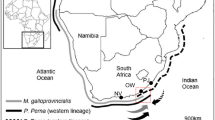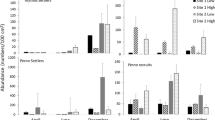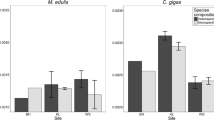Summary
The intertidal mussels Mytilus edulis and M. californianus compete for space on the west coast of North America. An analysis of differences in size, growth rate, age at first reproduction, life span, mode of reproduction, niche and habitats between these two species demonstrates that their life history strategies are different in several important ways. M. californianus is a larger, sturdier, slower growing mussel which has effective predator-deterring mechanisms and is an overall superior competitor for space in the intertidal. Its reproductive strategy is based on continually spawning at a very low level throughout a yearly cycle. M. edulis is a classic fugitive species which rarely attains a large size but matures early and is characterized by a single massive reproductive output each year. The differences noted in their life history strategies are very likely the result of either a) a “pre-adaptation” for coexistence, or b) a competitively-induced regional evolutionary divergence.
In Washington a band of small M. edulis (removed from most predation and competition) exists in a high intertidal spatial refuge, and contributes relatively little to the gene pool. Larger individuals exist in disturbed areas lower in the intertidal zone. These lower zones represent a relatively high risk, and usually only temporary, habitat for M. edulis because of mortality due to competition and predation. Individuals, however, colonizing these two intertidal patches contribute 43 times as much as their high intertidal counterparts in terms of reproductive fitness (calculated on a populationwide basis).
Similar content being viewed by others
References
Ackerman JM (1971) The demography of the marine mussel, Mytilus californianus. Ph.D. Dissertation, Univ Calif Berkeley
Allen EB, Forman RTT (1976) Plant species removals and old-field community structure and stability. Ecology 57 (6):1233–1243
Alm G (1959) Connection between maturity, size, and age in fishes. Rep Inst Freshw Res Drottingholm 40:5–145
Baird RH (1966) Factors affecting the growth and condition of mussels (Mytilus edulis). Fishery Invest., London Ser II 25:1–23
Baird RH, Drinnan RE (1957) The ratio of shell to meat in Mytilus as a function of tidal exposure to air. Journ Cons Perm Int Explor Mer 22:329–336
Ballinger RE (1977) Reproductive strategies: Food availability as a source of proximal variation in a lizard. Ecology 58:628–635
Barker RM (1970) Constituency and origins of cyclic growth layers in pelecypod shells. Ph D Dissertation Univ Calif, Berkeley
Barnes CA, Ebbesmeyer CC (1978) Some aspects of Puget Sound's circulation and water properties. Estuarine Transport Processes, BJ Kjerfve (ed), Univ. South Carolina Press
Bartlett B (1972) Reproductive ecology of the California sea mussel, Mytilus californianus Conrad. MS Thesis, Univ of the Pacific
Bayne BL (1964) Primary and secondary settlement in Mytilus edulis L. (Mollusca). Journ Anim Ecol 33:513–523
Brugam RB (1978) Human disturbance and the historical development of Lindsey Pond Ecology 59:19–36
Clark GR (1974) Growth lines in invertebrate skeletons. Ann Rev Earth and Planetary Sciences 2:77–99
Coe WR (1932) Season of attachment and rate of growth of sedentary marine organisms at the pier of the Scripps Insitite of Oceanography, La Jolla, California Bull Scripps Inst Oceanogr Tech Ser 3:37–86
Coe WR, Fox KL (1942) Biology of the California sea-mussel (Mytilus californianus). I. Influence of temperature, food supply, sex and age on the rate of growth. Journ Exp Zool 90:1–30
Cole LC (1959) The population consequences of life history phenomena. Quart Rev Biology 29:103–137
Craig GY, Hallam A (1963) Size-frequency and grwoth-ring analyses of Mytilus edulis and Cardium edule, and their palaeoecological significance. Paleontology 6:731–750
Darwin CR (1959) The Origin of Species by Natural Selection. John Murray, London
Dayton PK (1971) Competition, disturbance, and community organization: the provision and subsequent utilization of space in a rocky intertidal community. Ecol Monogr 41:351–389
Dayton PK (1975) Experimental evaluation of ecological dominance in a rocky intertidal algal community. Ecol Monogr 45(2):137–159
Dayton PK, Hessler RR (1972) Role of biological disturbance in maintaining diversity in the deep sea. Deep Sea Research 19:199–208
Dayton PK, Robilliard GA, Paine RT (1970) Benthic faunal zonation as a result of anchor ice at McMurdo Sound, Antarctica. Antarctic Ecology 1:244–258
Dehnel PA (1956) Growth rates in latitudinally and vertically separated populations of Mytilus californianus. Biol Bull 110:43–53
Dodd JR (1964a) Paleoecological implications of shell mineralogy in two pelecypod species. Journ Geology 71:1–11
Dodd JR (1964b) Environmentally controlled variation in the shell structure of a pelecypod species. Journ Paleontology 38:1065–1071
Edmondson WT (1970) Phosphorus, nitrogen, and algae in Lake Washington after diversion of sewage. Science 169:690–691
Elvin DW (1974) Oogenesis in Mytilus californianus. Ph D Dissertation Oregon State Univ Corvallis
Field IA (1922) Biology and economic value of the sea mussel Mytilus edulis. Bull US Bur Fish Wash 38:127–259
Fisher RA (1930) The Genetical Theory of Natural Selection. Oxford Univ Press, London
Fox DL, Coe WR (1943) Biology of the California sea mussel (Mytilus californianus) II. Nutrition, metabolism, growth and calcium deposition. Journ Exp Zool 93:205–249
Gabbott PA (1976) Energy metabolism. In: Marine Mussels: Their Ecology and Physiology, B L Bayne (ed) Cambridge Univ Press Cambridge p. 293–355
Gabbott PA, Bayne BL (1973) Biochemical effects of temperature and nutritive stress on Mytilus edulis L. Journ Mar Biol Assoc UK 53:269–286
Gadgil M, Bossert WH (1970) Life historical consequences of natural selection. Amer Nat 104:1–24
Gadgil M, Solbrig OT (1972) The concept of r- and K- selection: evidence from wild flowers and some theoretical considerations. Amer Nat 106:14–31
Giesel JT (1976) Reproductive strategies as adaptations to life in temporally heterogeneous environments. Ann Rev Ecol Syst 7:57–79
Graham HW, Gay H (1945) Season of attachment and growth of sedentary marine organisms at Oakland, California. Ecology 26:375–386
Hairston NG, Tinkle DW, Wilbur HM (1970) Natural selection and the parameters of population growth. Journ Wildlife Management 34:681–690
Harger JRE (1967) Population studies on Mytilus communities. Ph D Dissertation Univ of Calif Santa Barbara
Harger JRE (1968) The role of behavioral traits in influencing the distribution of two species of sea mussel, Mytilus edulis and Mytilus californianus Veliger 11:45–49
Harger JRE (1970a) The effect of wave impact on some aspects of the biology of sea mussels. Veliger 12:401–414
Harger JRE (1970b) Comparisons among growth characteristics of two species of sea mussel, Mytilus edulis and Mytilus californianus. Veliger 13:44–56
Harger JRE (1970c) The effects of species composition on the survival of mixed populations of the sea mussels Mytilus californianus and Mytilus edulis. Veliger 13:147–152
Harger JRE (1972a) Variation and relative “niche” size in the sea mussel Mytilus edulis in association with Mytilus californianus. Veliger 14:275–283
Harger JRE (1972b) Competitive coexistence: Maintenance of interacting associations of the sea mussels Mytilus edulis and Mytilus californianus. Veliger 14:387–410
Harger JRE (1972c) Competitive coexistence among intertidal invertebrates. Amer Sci 60:600–607
Harper JL (1977) Population Biology of Plants. Academic Press, New York.
Harper JL, Clatworthy JN, McNaughton IH, Sagar GR (1961) The evolution and ecology of closely related species living in the same area. Evolution 15:209–227
Heinselman ML (1973) Fire in the virgin forests of the Boundary Waters Canoe Area, Minnesota. Journ Quat Res 3:329–382
Henry JD, Swan JMA (1974) Reconstructing forest history from live and dead plant material — an approach to the study of forest succession in southwestern New Hampshire. Ecology 55:772–783
Hirshfield MF, Tinkle DW (1975) Natural selection and the evolution of reproductive effort. Proc Nat Acad Sci 72:2227–2231
Kennedy VS (1976) Desiccation, higher temperatures and upper intertidal limits of three species of sea mussels (Mollusca: Bivalvia) in New Zealand. Mar Biol 35:127–137
King CE, Anderson WW (1971) Age-specific selection II. The interaction between r and K during population growth. Amer Nat 105:137–156
Levin SA, Paine RT (1974) Disturbance, patch formation, and community structure. Proc Nat Acad Sci 71:2744–2747
Levinton JS, Suchanek TH (1978) Geographic variation, niche breadth and genetic differentiation at different geographic scales in the mussels Mytilus californianus and M. edulis. Mar Biol 49:363–375
Loya Y (1972) Community structure and species diversity of hermatypic corals at Eilat, Red Sea Mar Biol 13:100–123
Loya Y (1976) Recolonization of Red Sea corals affected by natural catastrophes and man-made perturbations. Ecology 57:278–289
Lutz RA (1976) Annual growth patterns in the inner shell layer of Mytilus edulis L. Journ Mar Biol Assoc UK 56:723–731
MacArthur RH, Levins R (1964) Competition, habitat selection, and character displacement in a patchy environment. Proc Nat Acad Sci 51:1207–1210
MacArthur RH, Levins R (1967) The limiting similarity of convergence and divergence of coexisting species. Amer Nat 101:377–385
MacArthur RH, Wilson EO (1967) The Theory of Island Biogeography. Monographs on Population Biology 1. Princeton Univ Press, Princeton, p 203
Marincovich L Jr (1973) Intertidal mollusks of Iquique, Chile Nat Hist Mus Los Angeles Co Sci Bull 16:1–49
McNaughton SJ (1975) r- and K-selection in Typha. Amer Nat 109:251–261
Menge BA (1974) Effect of wave action and competition on brooding and reproductive effort in the seastar, Leptasterias hexactis. Ecology 55 (1):84–93
Moore DR, Reish DJ (1969) Studies on the Mytilus edulis community in Alamitos Bay, California. 4. Seasonal variation in gametes from different regions in the bay. Veliger 11:250–255
Mountford MD (1968) The significance of litter size. Journ Anim Ecol 37:363–367
Murdoch WW (1966) Population stability and life history phenomena. Amer Nat 100:5–11
Nichols JD, Conley W, Batt B, Tipton AR (1976) Temporally dynamic reproductive strategies and the concept of r- and K-selection. Amer Nat 110:995–1005
Orton JH (1926) On the rate of growth of Cardium edule. Part I. Experimental observations. Journ Mar Biol Assoc UK 14:239–279
Paine RT (1966) Food web complexity and species diversity. Amer Nat 100:65–75
Paine RT (1971) A short-term experimental investigation of resource partitioning in a New Zealand rocky intertidal habitat. Ecology 52:1096–1106
Paine RT (1974) Intertidal community structure. Experimental studies on the relationship between a dominant competitor and its principal predator. Oecologia 15:93–120
Paine RT (1976a) Size-limited predation: An observational and experimental approach with the Mytilus-Pisaster interaction. Ecology 57:858–873
Paine RT (1976b) Biological observations on a subtidal Mytilus californianus bed. Veliger 19:125–130
Paine RT, Vadas RL (1969) The effects of grazing by sea urchins, Strongylocentrotus spp. on benthic algal populations. Limnol and Oceanogr 14:710–719
Pannella G, MacClintock C (1968) Biological and environmental rhythms reflected in molluscan shell growth. Journ Paleontology 23:577–594
Payne RB (1974) The evolution of clutch size and reproductive rates in parasitic cuckoos. Evolution 28:169–181
Pianka ER (1970) On r- and K-selection. Amer Nat 104:592–597
Pianka ER (1972) r and K selection or b and d selection. Amer Nat 106:581–588
Pianka ER (1974) Evolutionary Ecology. Harper and Row, New York pp 356
Price RW (1974) Strategies for egg production. Evolution 28:76–84
Randolph PA (1973) Influence of environmental variability on land snail population properties. Ecology 54:933–955
Rao KP (1953) Rate of water propulsion in Mytilus californianus as a function of latitude. Biol Bull Mar Biol Lab Woods Hole Mass 104:171–181
Rao KP (1954) Tidal rhythmicity of rate of water propulsion in Mytilus and its modificibility of transplantation. Biol Bull Mar Biol Lab Woods Hole Mass 106:353–359
Reish DJ (1964) Studies on the Mytilus edulis community in Alamitos Bay, California. 1. Development and destruction of the community. Veliger 6:124–131
Richards PW (1952) The Tropical Rain Forest. Cambridge Univ. Press, Cambridge
Richards PW, Williamson GB (1975) Treefalls and patterns of understory species in a wet lowland tropical forest. Ecology 56:1226–1229
Ricklefs RE (1977) On the evolution of reproductive strategies in birds: reproductive effort. Amer Nat 111:453–478
Roughgarden J (1971) Density-dependent natural selection. Ecology 52:453–468
Schaffer WM (1974) Selection for optimal life histories: the effects of age structure. Ecology 55:291–303
Scheer BT (1945) The development of marine fouling communities. Biol Bull 89:103–121
Seed R (1969a) The ecology of Mytilus edulis L. (Lamellibranchiata) on exposed rocky shores. 1. Breeding and settlement. Oecologia 3:277–316
Seed R (1969b) The ecology of Mytilus edulis L. (Lamellibranchiata) on exposed rocky shores. 2. Growth and mortality. Oecologia (Berl) 3:317–350
Seed R (1973) Absolute and allometric growth in the mussel, Mytilus edulis L. (Mollusca: Bivalvia). Proc Mal Soc London 40:343–357
Seed R (1975) Reproduction in Mytilus (Mollusca: Bivalvia) in European waters. Pubblicasioni della Stazione Zoologica de Napoli, Milan
Seed R (1976) Ecology. In: Marine Mussels: Their Ecology and Physiology, BL Bayne (ed) Cambridge Univ Press, Cambridge p 13–65
Snell TW, King CE (1977) Life span and fecundity patterns in rotifers: the cost of reproduction. Evolution 31:882–890
Soot-Ryen T (1955) A report on the family Mytilidae (Pelecypoda). Allan Hancock Pacific Expeditions 20:1–174
Stearns SC (1976) Life history tactics; A review of the ideas. Quart Rev Biol 51:3–47
Stearns SC (1977) The evolution of life history traits: A critique of the theory and a review of the data. Ann Rev Ecol Syst 8:145–171
Stephenson TA, Stephenson A (1972) Life Between Tidemarks on Rocky Shores. WH Freeman & Co, San Francisco 425 pp
Stohler R (1930) Beitrag sur kenntnis des geschlechtszyklus von Mytilus californianus Conrad Zoologischer Anzeiger 90:263–268
Stubbings HG (1954) The biology of the common mussel in relation to fouling problems. Research 7:222–229
Suchanek TH (1978) The ecology of Mytilus edulis L. in exposed rocky intertidal communities. Journ Exp Mar Biol Ecol 31:105–120
Suchanek TH (1979) The Mytilus californianus community: Studies on the composition, structure, organization, and dynamics of a mussel bed. Ph.D. Dissertation, Dept of Zoology, Univ of Wash Seattle
Suchanek TH (1980) Diversity in natural and artificial mussel bed communities of Mytilus californianus. [Abstr.] Amer Zool 20:807
Svardson G (1949) Natural selection and egg number in fish. Ann Rep Inst Freshw Res Drottingholm 29:115–122
Thompson RJ, Ratcliffe NA, Bayne BL (1974) Effects of starvation on structure and function in the digestive gland of the mussel (Mytilus edulis L.). Journ Mar Biol Assoc UK 54:699–712
Tilley SG (1973) Life histories and natural selection in populations of the salamander Desmognathus ochraphaeus. Ecology 54:3–17
Tinkle DW (1969) The concept of reproductive effort and its relation to the evolution of life histories of lizards. Amer Nat 103:501–516
Tinkle DW, Wilbur HM, Tilley SG (1970) Evolutionary strategies in lizard reproduction. Evolution 24:55–74
Whedon WF (1936) Spawning habits of the mussel Mytilus californianus with notes on the possible relation to mussel poison. Univ of Calif Publications in Zoology 41:35–44
White KM (1937) Mytilus. Liverpool Marine Biology Committee Memoirs; No. 31, Univ of Liverpool Press, Liverpool
Wilbur HM, Tinkle DW, Collins JP (1974) Environmental certainty, trophic level, and resource availability in life history evolution. Amer Nat 108:805–817
Williams GC (1966a) Adaptation and Natural Selection. Princeton Univ Press, Princeton, p 307
Williams GC (1966b) Natural selection, the costs of reproduction, and a refinement of Lack's principle. Amer Nat 100:687–692
Young RT (1942) Spawning season of the California mussel, Mytilus californianus. Ecology 23:490–492
Young RT (1946) Spawning and settling season of the mussel, Mytilus californianus. Ecology 27:354–363
Author information
Authors and Affiliations
Rights and permissions
About this article
Cite this article
Suchanek, T.H. The role of disturbance in the evolution of life history strategies in the intertidal mussels Mytilus edulis and Mytilus californianus . Oecologia 50, 143–152 (1981). https://doi.org/10.1007/BF00348028
Received:
Issue Date:
DOI: https://doi.org/10.1007/BF00348028




